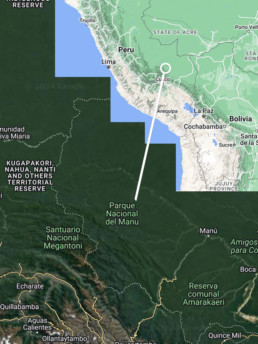Location
Challabamba & Kosñipata district, Paucartambo province, Cusco Department, Peru
Goal
To restore and rewild the upper limits of Amazonian cloud forests and learn more about spectacled bears there
Project Field Partner
Conservación Amazónica (ACCA) are a Peruvian non-profit organization that has been working since 1999 on the conservation and enhancement of the Amazonian forests. They create sustainable alternatives for local populations, based on science, technology, and innovation. They are pioneers in protecting the biological diversity of one of the planet’s richest areas: the Amazonian Andes of Peru.
Size of Area Involved
9,119 hectares

Climate Change Adaptation
The vast scale of Manú National Park—spanning Andean highlands, cloud forest and lowland Amazonian fortest—makes it a stronghold for apex predators and species with large home ranges or that are rare and widely distributed. The elevational range of Manú, from 300 feet to 11,000 feet above sea level, enhances its importance for the ability of species to adapt to climate change. The spectacled bear (‘Ukuku’ in Quechua) is a cultural icon for the Quechua indigenous people because its movements replicate the seasonal migrations of the ancestral Quechua and traditional groups like the Keros Quechua, who migrate with the seasons to move crops and livestock into different life zones. These highly arboreal bears are one of the few large mammal species to move freely from cloud forest to upper elevation grasslands and thus may play an important role in seed dispersal. The species is designated as Vulnerable and its population is decreasing.

Threats:
The main threats to the highest cloud forest in the Amazon basin are overgrazing and burning from above and an upward shift in plant community assemblages from below.
Restoring Harmony
The project combines engagement with local communities—to restore and rewild degraded areas in the upper limits of Amazonian cloud forests—with a study to understand the movements and diet of bears and their role in plant dispersal. Project highlights include:
- Installation of 96 camera traps in 2022 to better understand the seasonal movements of spectacled bears between habitats—from lowland rainforest to the Andean Puna grassland. The camera traps were placed every 50m of elevation, along an altitudinal gradient of 550-3950 meters above sea level (masl). In total 12,650 wildlife images were processed, including 137 independent spectacled bear detections. ACCA project staff also recorded 17 new individuals, including three mothers with cubs. To date, 37 bears have been identified in the project area.
- Successful propagation of 24 native tree species and production of more than 125,644 seedlings in 2022. Due to delays in the start of the rainy season, only 50,000 were planted last year. The goal is to plant all the trees produced in the first half of 2023.
- Inauguration of the new ‘Andean Bear Interpretation Center’ near the Wayqecha Biological Station in 2022. The center will play an important role in raising awareness about key species and Andean-Amazonian ecosystems, as well as, connecting visitors with science and nature through illustrations, sculptures, photographs, and videos. In total, 350 people were taught at the interpretation center in 2022.
Andean bear expedition, june 2021 photos : Ruthmery Pillco Huarcaya



